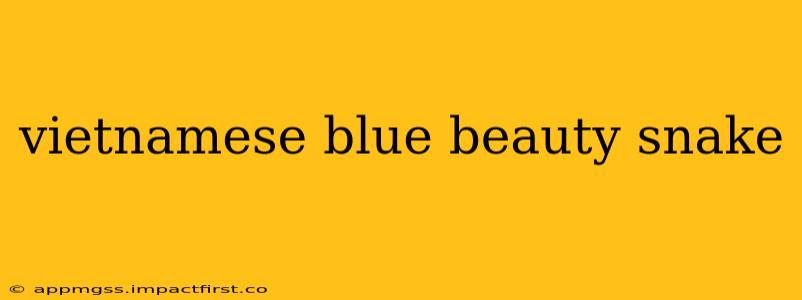The Vietnamese blue beauty snake, scientifically known as Calliophis intestinalis, captivates with its striking azure scales and elusive nature. This relatively small, yet fascinating creature, belongs to the family Elapidae, a group known for containing some of the world's most venomous snakes. However, despite its venomous nature, the blue beauty presents a relatively low threat to humans due to its docile temperament and small fangs. Let's delve deeper into the mysteries surrounding this captivating reptile.
What are the key characteristics of the Vietnamese blue beauty snake?
The Vietnamese blue beauty snake is easily identified by its vibrant, iridescent blue scales. These scales are often interspersed with black markings, creating a striking visual contrast. Its slender body typically ranges from 25 to 50 centimeters in length. Unlike many venomous snakes known for their aggressive behavior, the blue beauty is generally shy and prefers to avoid confrontation. Its small size and relatively small fangs also contribute to its lower risk to humans. They feed primarily on other snakes, specifically smaller burrowing species.
Is the Vietnamese blue beauty snake venomous?
Yes, the Vietnamese blue beauty snake is venomous. However, it's crucial to understand that its venom is considered neurotoxic, meaning it affects the nervous system. While capable of delivering a bite, the amount of venom injected is usually small, and serious envenomation in humans is rare. Furthermore, their docile nature makes bites infrequent. However, it's always best to approach any wild snake with caution and respect, regardless of its perceived danger level.
Where does the Vietnamese blue beauty snake live?
As its name suggests, the Vietnamese blue beauty snake is primarily found in Vietnam, inhabiting the mountainous regions of the country. Their habitat consists of humid forests and areas with rich leaf litter where they can easily conceal themselves and hunt. Specific geographic ranges may vary, and research is ongoing to pinpoint their precise distribution within Vietnam and possibly adjacent areas.
What does the Vietnamese blue beauty snake eat?
The Vietnamese blue beauty snake is a specialist predator, with a diet that primarily consists of other snakes. It often targets smaller, burrowing species, demonstrating a specific hunting strategy adapted to its prey. Further research on its diet could reveal more nuanced details about its feeding habits and ecological role.
How dangerous is the Vietnamese blue beauty snake to humans?
While venomous, the Vietnamese blue beauty snake poses a relatively low threat to humans. Its small size, small fangs, and docile nature greatly reduce the likelihood of a bite and the severity of any potential envenomation. However, it's crucial to remember that any venomous snake bite should be treated with appropriate medical attention. Avoid handling the snake, and seek immediate medical care if bitten.
What is the conservation status of the Vietnamese blue beauty snake?
The conservation status of the Vietnamese blue beauty snake is currently not well defined, lacking comprehensive assessments. However, the increasing loss of its forest habitat due to deforestation and human encroachment poses a potential threat to its population. Further research and monitoring are crucial to assess its conservation needs and ensure the long-term survival of this fascinating species.
Author Note: This information is for educational purposes only. The author is not a herpetologist, and this information should not be substituted for professional advice. Always seek professional medical help if you encounter a snake bite. Further research is ongoing into many aspects of the Vietnamese blue beauty snake's biology and ecology.
